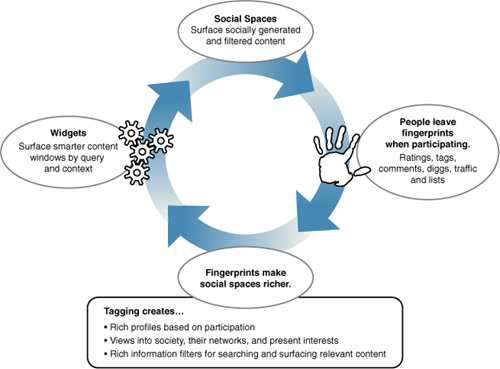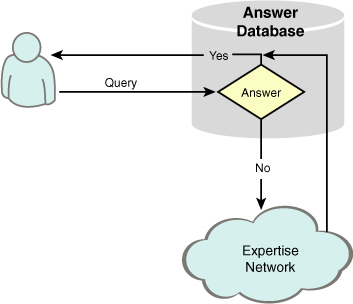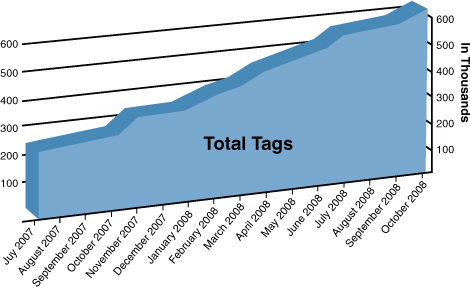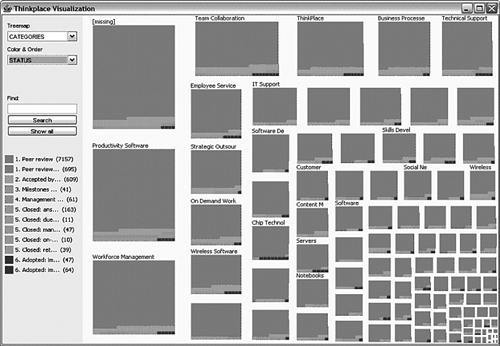So now you know we’re in the Social Age! We explored some of the trends and innovations that got us here, and you’ve begun to get a flavor for the incredible power of wikis, blogs, and other Social Age tools in the enterprise. We think you’re probably ready for a trip into the clouds.
Social Age clouds are not big, puffy things in the sky from which rain falls. Social Age clouds are really “clouds of knowledge,” which incorporate services and information, making both easily accessible from anywhere. These clouds are a key enabler for our smaller, smarter, and more social world. These clouds are why people in the Social Age generation can take for granted that the web page they’re looking at is “smart.” That is, we now expect the web page we look at to know who we are, what we want to read, and to suggest other web pages, services, or products in which we might be interested. We expect that when information or events change on our favorite site, we’ll be aware of it immediately, including receiving proactive notification, depending on our profile.
Early clouds are with us today, and more clouds are rapidly forming to take advantage of the global transformation now underway. Clouds will become even more pervasive and encompass ever-increasing knowledge as more people commit to this medium and increasingly engage in social networking activities.
Social Age clouds are available worldwide and include collective knowledge unimaginable just a few years ago. They can be either “tag clouds” that aggregate social behavior and community interests or “computer clouds” (better known as cloud computing), which we discuss in detail in Chapter 6, “Cloud Computing Paradigm.”
At least for now there’s not a lot of interaction between various services in these clouds. In other words, open standards are still evolving that ultimately will facilitate the integration or exchange of information with other social tools. For example, perhaps you use a social networking site, and during registration, you were asked to invite your friends from your Gmail or Yahoo distribution lists. Soon these questions will be unnecessary as new standards for data exchange emerge and the maturation of cloud computing accelerates. Driven by market pressures, these open standards and web services protocols will dramatically increase the collective information available in the cloud.
Of the two categories—tag clouds and cloud computing—tag clouds are perhaps the most interesting to the average Internet user. Tag clouds are an aggregation of personally created keywords that can be applied to either content or people. You can tag a web page, a document, a video, some new music, a friend’s blog, some wiki comments, a book, a collection of bookmarks, or even a person.
Tagging is the action or process by which an individual can label and classify an item. Social networking communities share an enthusiasm for the pastime of tagging, making it the primary driver for the collection and availability of tags. Tag clouds are virtual entities in the Social Age that are aware of community preferences and behavior through the aggregation and analysis of tags.
In the Social Age, the practice of tagging is an organic process usually referred to as folksonomy.[1] Previously the classification of information and objects (whether people or things) was the exclusive domain of the highly specialized science of taxonomy. Now through the folksonomy of social networking, everyone is getting into the act! The primary advantage of communities and especially businesses participating in the exercise of tagging is that it generates a group preference or classification that specifically reflects the needs and desires of the collective.
Folksonomies create a powerful bridge between the individual and the collective, and they differ fundamentally from formal taxonomies. Typical IT taxonomies are carefully structured by specialists to define data dictionaries for databases. IT taxonomies define data structures and data relationships that are central to achieving a good data definition about relatively static data relationships, supporting well-defined transactions. Examples of such well-defined transactions include financial and accounting data.
Folksonomies, on the other hand, are created organically by individuals who classify items within specific communities of interest, based on personal opinions and value systems. Unlike taxonomies, folksonomies evolve dynamically and constantly as the interests and composition of the community changes. The process of creating a folksonomy is highly efficient because it leverages the collective knowledge of a community, a business, or an entire society.
A wealth of information and objects can be tagged on the Web and inside an organization’s firewall that are of great value to your business. These community-created tag clouds are the latest, most accurate representations of what’s important to that community. These tag clouds are often represented visually on a Web site, with various font sizes or other attributes to distinguish relative popularity, as illustrated in Figure 5.1.
Figure 5.1. The virtuous cycle of tagging produces an increasingly valuable tag cloud that can be used by other web applications and services to examine buying behaviors and community preferences.
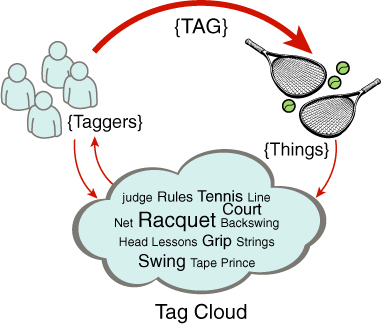
For your business, the intelligence contained in tag clouds—inside and outside your organization—is incredibly valuable; and most surprisingly, in the Social Age, such intelligence is available to you at little or no cost!
Tagging empowers people within a community to build relationships and associations as they share their thoughts and opinions. A sense of community identity develops as each member contributes to the team through the shared classification, evaluation, and ranking of people and objects.
Amazon.com is an excellent example of the power of tagging. Have you found yourself checking the star ranking before buying something on Amazon? Do you read the opinions of other buyers before you click “Add to Cart?” Most of us do!
For Amazon.com and thousands of other savvy retailers, tag clouds can easily be leveraged to create “cash clouds” that drive revenue and quickly enhance the reputation of a product. In addition to opinions and stars rankings, Amazon.com also offers the opportunity to tag items, making them easier to find later or to highlight in a social networking community. Perhaps you’re considering a new watch. You can tag the watches you like and then use that tag category any time to compare them side by side. Or maybe you think there should be a category of watch called “diver.” You’re free to create that category for your benefit or for the benefit of other visitors to Amazon. All this and more is possible only through the power of tagging!
Visitors to Amazon.com and other retailer Web sites depend on tags and reviews to get the real word on products. They trust what they read because it is the opinion of other consumers who have actually used the products, rather than a review or biased opinion of the manufacturer. Every review, categorized by reviewer, is available at any time, allowing a visitor to confirm the credibility and review the record of each reviewer. Tags and reviews help drive the sales of the best products, and more quickly eliminate weak products.
Basic human curiosity and a need for affirmation are the reasons we reach out to others to get their opinions, or to get the comfort that the opinion of a community provides. This basic social instinct is why people seek recommendations from others, spend time tagging, and enjoy spreading the word about what’s considered cool.
The tag cloud is an entirely new method of communication that reveals ever-evolving characteristics of a community—what’s important to them, what motivates them, what problems they’re confronting, what they need, and of course what they’re buying now and might be willing to buy in the future. As Amazon.com has happily discovered, tag clouds offer your business a powerful new way to market products.
As always, community opinion is important, but now it carries even greater weight because it is not just immediate and close friends providing recommendations. Now a long tail of loosely connected people you barely know can offer incredible insights on topics that interest you. As discussed in Chapter 4, “Blogs: Your Personal News Outlet,” this long tail of loose connections is a powerful aspect of blogs.
In a world of information overload, tags offer a welcome relief. Tag clouds quickly highlight topics, activities, conferences, people, or any other items of interest to an individual or a business that have been recommended and highly ranked by a community through the aggregation of tags. Popular topics and themes tend to bubble to the top of tag clouds quickly. Tags create a ranking process, separating good content from bad, identifying best values, and saving substantial time and frustration for community members. Tags create associations and correlations that can be used to understand group preferences and relationships between different items.
Perhaps the most surprising aspect of the tag clouds is that the same relevant content surfaces regardless of web application or tag tool experience. The extraordinary consistency of community behavior on tag cloud content, regardless of the tool used for the tagging, reveals profound unity, almost as if the community had a “mind of its own.” To succeed today, your business must focus as much on the community as on the individual.
Tag clouds consist of tags that are essentially “social fragments” that reflect the interests and preferences of a community. As such, they tend to foster greater understanding of social behavior, inclinations, and interactions within communities. In addition, two key advantages of aggregating individual tags into a tag cloud are the statistical elimination of individual biases and providing a context for tagged objects.
For example, if you’re a tennis player and belong to one of the many social networking groups for tennis fans, you’ll probably get relatively unbiased recommendations of top tennis rackets that fit your expectations and needs. The tag cloud contains ratings from thousands of tennis players and is the collective wisdom of the people who have researched the topic and have actually used the rackets. Even if a couple of tennis racket sales reps slip into the cloud, no worries! Their glowing—and obviously biased—recommendations of a particular racket are going to be tempered by the unbiased statistical majority of others in the cloud. In fact, the longer a community has been tagging, the more effective its cloud becomes. Essentially, every click in the tag cloud is a vote; together the cloud expresses precisely the preferences of the community within a particular context and without individual biases.
Context is everything in the quality of a web search. The tag cloud offers incredible insight regarding community members’ interests and opinions. As a result, when you search tag clouds, you generate results vastly superior to regular search methodologies, offering a clear, competitive advantage for your business.
Today more than 250 million people worldwide engage in social networking activities.[2] As a result, tagging is becoming the trusted reference and preferred way to classify objects. Tagging is an organic, dynamic process rather than a static, structured process. Your business must leverage the power of social networking because a community evaluation or ranking can quickly make or break a product. In this context, social networking is essentially a new marketing channel for your products and company reputation.
We also urge you to seriously evaluate the value of the tag cloud to improve the social spaces you create for your customers—forums, blogs, wikis, customer satisfaction survey pages, among others. As tagging becomes more pervasive, evaluation and tagging mechanisms will simultaneously become more sophisticated. New mechanisms will make web applications and services smarter and more capable of interacting and responding in ways unimaginable today. Creating a smart social environment to empower your customers to tag your products and provide feedback might be one of the smartest things you can do to improve your direct channel.
Tags are like fingerprints or an audit trail in social spaces that can provide a way for you to understand your customers’ preferences. What do your customers like? Well, you could call each of them on the phone and ask them; or you could just check online customer ratings of your products. While you’re at it, you can check tags, wiki comments, network traffic, lists, bookmarks, and other “taggable” events wherever they appear, whether on your product web page or out in the external tag cloud. Using the power of the tag cloud, you’ll know what your customers like—for sure! (Keep in mind you might not always like the results you see. But when would you rather find out about a problem? Now, through the tag cloud? Or when the monthly sales report tells you a particular product is one of your worst sellers? This, coincidentally, might be the day after you place a big order for that item with your supplier!)
In addition to the many benefits previously mentioned, the tagging process also enables a virtuous cycle of social networking—virtuous because with each discrete piece of community input, the social network becomes more reliable, trustworthy, and important to its members (see Figure 5.2). Tags enable the virtuous cycle of social networking by surfacing content that is made available to the social networking spaces. In turn, these virtual spaces provide a conduit for more tagging that keeps the community vibrant and accurately reflecting the interests of the collective.
Keep in mind that because of the interconnectedness of the smart web pages created through tags, a networking space can consist of many different social networking tools that share the same community interest within a single tag cloud. As the community changes its preferences, the tags will change and the tag cloud will surface other documents and items, making the social space an accurate reflection of common interests and values of the community. The tag cloud allows us to see the relationship among the individual, the collective, and the shared social spaces, as illustrated in Figure 5.2.
By now, you have probably realized the significant value and incredible power of tag clouds for your business. So what is the most effective way to apply a tag cloud to the enterprise? How can tags help improve your business search engine? What tag cloud services are applicable to corporations?
One of the key benefits of implementing a tag cloud service within the enterprise is the cultural transformation that occurs through tagging. Properly implemented, tagging can make the corporation increasingly people-centric and unleash the collective knowledge and experience of its employees. Just as public tag clouds foster greater understanding through shared interests and mutually beneficial folksonomies, tagging within the enterprise helps build stronger corporate communities and teams. In the enterprise, you can tag documents and internal Web sites to more easily highlight content of interest to specific business communities.
The tag cloud empowers businesses to tune their search engines to reflect the interests and values of the corporation and their communities. This tuning creates efficiencies in information identification that can significantly improve employee morale and customer satisfaction. In addition, as previously discussed, the virtuous cycle is accelerated in your business through a well-established tag system. The tag system helps people find the information most relevant to them and this, in turn, has an effect on the overall web traffic on the most popular pages.
Two years ago at IBM, we designed a cross-business-unit solution called the Enterprise Tagging Service (ETS), which provided common services accessible to IT internal applications to ensure every tag generated was collected in a common data repository. These tags were correlated and made available in many different ways to satisfy specific application needs, regional and local requirements, and the business needs of other internal communities. The ETS team designed a tag aggregation service for applications to publish and consume tag data and a tag analytics program to define how to apply tags in multiple contexts. The ETS framework was well documented and several example widgets were created to enable easy access and attachment of these artifacts to web pages everywhere within the firewall.
Note that tag widgets were created to facilitate adoption of the technology. Again we return to the importance of proper planning and implementation to ensure the success of your tag cloud. The tag widgets should have simple interfaces to make it easy to integrate them into Web sites.
The IBM tag widgets illustrated in Figure 5.3 are easy to implement and can be attached to web documents and applications in just a few steps. We created these tag widgets by leveraging Web 2.0 technologies and then made them easily available to IBMers to customize and attach everywhere within the internal firewall.
Figure 5.3. (Left to right) (1)“Tagger” widget listing tags based on configurable categories; (2) tag cloud, represented by relative font size, the popularity of the tag, or particular application; (3) tag cloud widget rendering the tags associated with a particular web page or web application.

The result of implementing a companywide tagging system was an avalanche of participants eagerly tagging all kinds of information. Technical and nontechnical employees participated equally in the creation of new, simple tagging widgets, which they attached to many of their favorite sites and applications. It seemed everyone was jumping into the tagging frenzy. After the establishment of the tagging service, the internal Web site traffic pattern was actually altered by the new tag cloud—nearly 70 percent of the site traffic was related in some way to the ETS redirects. This was a perfect example of the influence a community can have on employee behavior.
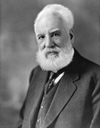
Alexander Graham Bell, Library and Archives Canada
• In the Social Age everything is about the “clouds of knowledge” that incorporate services and information, making them easily accessible everywhere.
• Tag clouds encapsulate social behavior and community interests. These tags are user-generated keywords applied to content or people.
• Tag clouds represent the preferences, values, and associations of a community. Tag clouds build bridges between the individual and the collective.
• Expertise location is much more effective through the use of social networking tools.

